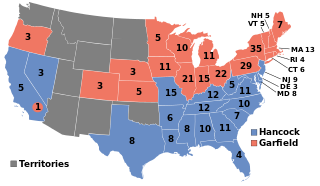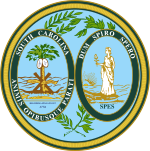
Presidential elections were held in the United States on November 7, 1876. Republican Governor Rutherford B. Hayes of Ohio very narrowly defeated Democrat Governor Samuel J. Tilden of New York. Following President Ulysses S. Grant's decision to retire after his second term, U.S. Representative James G. Blaine emerged as frontrunner for the Republican nomination; however, Blaine was unable to win a majority at the 1876 Republican National Convention, which settled on Hayes as a compromise candidate. The 1876 Democratic National Convention nominated Tilden on the second ballot.

Presidential elections were held in the United States on November 2, 1880. Republican nominee James A. Garfield defeated Winfield Scott Hancock of the Democratic Party. The voter turnout rate was one of the highest in the nation's history. Garfield was assassinated during his first year in office, and he was succeeded by his vice president, Chester A. Arthur.

The 1876 South Carolina gubernatorial election was held on November 7, 1876, to select the governor of the state of South Carolina. The election campaign was a referendum on the Radical Republican-led state government and their Reconstruction policies. Opponents disputed the challenger Wade Hampton III's victory, gained by a margin of little more than 1100 votes statewide. But he took office in April 1877, after President Hayes withdrew federal troops as a result of a national Democratic compromise, and the incumbent Daniel Henry Chamberlain left the state.

The 1878 South Carolina gubernatorial election was held on November 5, 1878 to select the governor of South Carolina. Wade Hampton III was renominated by the Democrats and ran against no organized opposition in the general election to win reelection for a second two-year term.

The 1870 South Carolina gubernatorial election was held on October 19, 1870, to select the governor of the state of South Carolina. Governor Robert Kingston Scott easily won reelection based entirely on the strength of the black vote in the state. The election was significant because white conservatives of the state claimed it showed that political harmony between the white and black races was impossible and only through a straightout Democratic attempt would they be able to regain control of state government.

Johnson Hagood was a planter, soldier and military officer in the Confederate States Army during the American Civil War, reaching the rank of brigadier general in the state militia and regular Confederate Army in 1862.

The 1882 South Carolina gubernatorial election was held on November 7, 1882 to select the governor of the state of South Carolina. Hugh Smith Thompson was nominated by the Democrats and ran against J. Hendrix McLane, a Greenback-Labor candidate. Thompson easily won the general election and became the 81st governor of South Carolina.

The 1890 South Carolina gubernatorial election was held on Tuesday November 4, to elect the governor of South Carolina. Ben Tillman was nominated by the Democrats and easily won the general election against A.C. Haskell to become the 84th governor of South Carolina.

The 1892 South Carolina gubernatorial election was held on November 8, 1892, to select the governor of the state of South Carolina. Governor Ben Tillman was renominated by the Democrats and was elected in the general election to a second two-year term.

The 1894 South Carolina gubernatorial election was held on November 6, 1894 to select the governor of the state of South Carolina. John Gary Evans was nominated by the Democrats and became the 85th governor of South Carolina.

The 1896 South Carolina gubernatorial election was held on November 3, 1896 to select the governor of the state of South Carolina. William Haselden Ellerbe won the Democratic primary and easily won the general election to become the 86th governor of South Carolina.

The 1882 New York state election was held on November 7, 1882, to elect the governor, the lieutenant governor, the chief judge and a U.S. Representative-at-large, as well as all members of the New York State Assembly. Besides, two constitutional amendments were proposed - the abolition of tolls on the State canals, and to increase the number of justices on the New York Supreme Court - and were accepted by the electorate.

The 1885 New York state election was held on November 3, 1885, to elect the governor, the lieutenant governor, the secretary state, the state comptroller, the attorney general, the state treasurer and the state engineer, as well as all members of the New York State Assembly and the New York State Senate.

The 1882 United States House of Representatives elections in South Carolina were held on November 7, 1882, to select seven Representatives for two-year terms from the state of South Carolina. Following the 1880 census, the state was granted two additional seats in the House of Representatives. The Democratic controlled state legislature drew the districts to maximize the white vote and limit the black vote. Much of the black population was packed into the 7th congressional district which resulted in the other six congressional districts being evenly split between the races. The Democratic plan achieved its desired effect and the composition of the state delegation after the election was six Democrats and one Republican.
The following table indicates the party of elected officials in the U.S. state of Maine:

The 1878 New York state election was held on November 5, 1878, to elect a judge of the New York Court of Appeals, as well as all members of the New York State Assembly and one member of the New York State Senate to sit in the 102nd New York State Legislature.

The 1880 Greenback Party National Convention convened in Chicago from June 9 to June 11 to select presidential and vice presidential nominees and write a party platform for the Greenback Party in the United States presidential election 1880. Delegates chose James B. Weaver of Iowa for President and Barzillai J. Chambers of Texas for Vice President.

The 1908 West Virginia gubernatorial election took place on November 3, concurrently with the presidential election. Republican nominee William E. Glasscock was elected Governor of West Virginia, defeating Democratic nominee Louis Bennett Sr.

The 1878 Massachusetts gubernatorial election was held on November 5. Former acting Governor Thomas Talbot, a Republican, defeated Benjamin Butler, who ran as an independent Greenback candidate with Democratic support. Butler's supporters secured a majority of delegates to the Democratic state convention, but his nomination was rejected by the state party committee after his supporters used violent tactics to exclude anti-Butler delegates from the convention hall.
From 1894 to 1900 the North Carolina Republican Party and the Populist Party collaborated via electoral fusion to compete against the North Carolina Democratic Party. This political coalition was dubbed Fusionism.




















